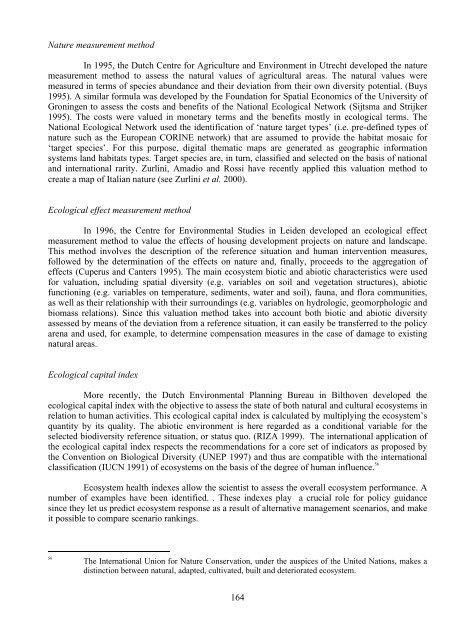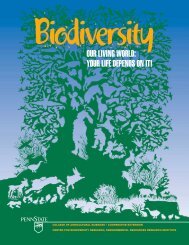Valuation of Biodiversity Benefits (OECD)
Valuation of Biodiversity Benefits (OECD)
Valuation of Biodiversity Benefits (OECD)
- No tags were found...
You also want an ePaper? Increase the reach of your titles
YUMPU automatically turns print PDFs into web optimized ePapers that Google loves.
Nature measurement methodIn 1995, the Dutch Centre for Agriculture and Environment in Utrecht developed the naturemeasurement method to assess the natural values <strong>of</strong> agricultural areas. The natural values weremeasured in terms <strong>of</strong> species abundance and their deviation from their own diversity potential. (Buys1995). A similar formula was developed by the Foundation for Spatial Economics <strong>of</strong> the University <strong>of</strong>Groningen to assess the costs and benefits <strong>of</strong> the National Ecological Network (Sijtsma and Strijker1995). The costs were valued in monetary terms and the benefits mostly in ecological terms. TheNational Ecological Network used the identification <strong>of</strong> ‘nature target types’ (i.e. pre-defined types <strong>of</strong>nature such as the European CORINE network) that are assumed to provide the habitat mosaic for‘target species’. For this purpose, digital thematic maps are generated as geographic informationsystems land habitats types. Target species are, in turn, classified and selected on the basis <strong>of</strong> nationaland international rarity. Zurlini, Amadio and Rossi have recently applied this valuation method tocreate a map <strong>of</strong> Italian nature (see Zurlini et al. 2000).Ecological effect measurement methodIn 1996, the Centre for Environmental Studies in Leiden developed an ecological effectmeasurement method to value the effects <strong>of</strong> housing development projects on nature and landscape.This method involves the description <strong>of</strong> the reference situation and human intervention measures,followed by the determination <strong>of</strong> the effects on nature and, finally, proceeds to the aggregation <strong>of</strong>effects (Cuperus and Canters 1995). The main ecosystem biotic and abiotic characteristics were usedfor valuation, including spatial diversity (e.g. variables on soil and vegetation structures), abioticfunctioning (e.g. variables on temperature, sediments, water and soil), fauna, and flora communities,as well as their relationship with their surroundings (e.g. variables on hydrologic, geomorphologic andbiomass relations). Since this valuation method takes into account both biotic and abiotic diversityassessed by means <strong>of</strong> the deviation from a reference situation, it can easily be transferred to the policyarena and used, for example, to determine compensation measures in the case <strong>of</strong> damage to existingnatural areas.Ecological capital indexMore recently, the Dutch Environmental Planning Bureau in Bilthoven developed theecological capital index with the objective to assess the state <strong>of</strong> both natural and cultural ecosystems inrelation to human activities. This ecological capital index is calculated by multiplying the ecosystem’squantity by its quality. The abiotic environment is here regarded as a conditional variable for theselected biodiversity reference situation, or status quo. (RIZA 1999). The international application <strong>of</strong>the ecological capital index respects the recommendations for a core set <strong>of</strong> indicators as proposed bythe Convention on Biological Diversity (UNEP 1997) and thus are compatible with the internationalclassification (IUCN 1991) <strong>of</strong> ecosystems on the basis <strong>of</strong> the degree <strong>of</strong> human influence. 56Ecosystem health indexes allow the scientist to assess the overall ecosystem performance. Anumber <strong>of</strong> examples have been identified. . These indexes play a crucial role for policy guidancesince they let us predict ecosystem response as a result <strong>of</strong> alternative management scenarios, and makeit possible to compare scenario rankings.56The International Union for Nature Conservation, under the auspices <strong>of</strong> the United Nations, makes adistinction between natural, adapted, cultivated, built and deteriorated ecosystem.164












